Optimization of Hybrid Ultrasonic Frequency Pulsed VP-GTAW Process Parameters on Tensile Properties of AA 5456 Alloy
Abstract
:1. Introduction
2. Experimental Procedure
2.1. Materials
2.2. Welding Process Parameters
2.3. Variation Range of Welding Process Parameters
2.4. Selection of Orthogonal Array
2.5. Tensile Property Test
3. Regression Analysis
3.1. Development of the Regression Models
3.2. Determination of the Regression Coefficients
3.3. Checking the Adequacy of the Regression Equations
3.4. Identification of the Validity of the Regression Equations
4. Results and Discussion
5. Conclusions
- (1)
- Regression models, which took tensile strength, yield strength, percent elongation, and ratio of reduction in area as the response functions of process parameters fL, fH, and ψ, were developed through least square estimation. The regression equations were proved to be effective by checking the coefficient of correlation r2 and confirmatory experiments.
- (2)
- The optimum parameters of HPVP-GTAW for AA 5456 aluminum alloy were obtained by analyzing the response surfaces and the contour plots of tensile properties based on regression equations. The optimum parameters were fL 1 kHz, fH 20 kHz and ψ 0.6 (i.e., Ib 75 A, Ip 180 A, and δ 0.2).
- (3)
- The maximum tensile properties were obtained with the above optimum parameters, and the microstructural observation illustrated that there was a great deal of second-phase β (Mg2Al3) uniformly distributed in the weld zone, which was beneficial to the improvement of the mechanical properties of AA 5456 aluminum alloy welded joints.
Acknowledgments
Author Contributions
Conflicts of Interest
References
- Manti, R.; Dwivedi, D.K.; Agarwal, A. Microstructure and hardness of Al-Mg-Si weldments produced by pulse GTA welding. Int. J. Adv. Manuf. Technol. 2008, 39, 851–865. [Google Scholar] [CrossRef]
- Elisan, D.S.M.; Ana, L.F.L.S.; Sandro, M.M.L.S. A GTA Welding Cooling Rate Analysis on Stainless Steel and Aluminum Using Inverse Problems. Appl. Sci. 2017, 7, 122. [Google Scholar] [CrossRef]
- Pan, J.; Hu, S.; Yang, L. Investigation of molten pool behavior and weld bead formation in VP-GTAW by numerical modelling. Mater. Des. 2016, 111, 600–607. [Google Scholar] [CrossRef]
- Kummar, A.; Sundarrajan, S. Optimization of pulsed TIG welding process parameters on mechanical properties of AA 5456 Aluminum alloy weldments. Mater. Des. 2009, 30, 1288–1297. [Google Scholar] [CrossRef]
- Karunakaran, N.; Balasubramanian, V. Effect of pulsed current on temperature distribution, weld bead profiles and characteristics of gas tungsten arc welded aluminum alloy joints. Trans. Nonferrous Metal. Soc. China 2011, 21, 278–286. [Google Scholar] [CrossRef]
- Giridharan, P.K.; Murugan, N. Optimization of pulsed GTA welding process parameters for the welding of AISI 304L stainless steel sheets. Inter. J. Adv. Manuf. Technol. 2009, 40, 478–489. [Google Scholar] [CrossRef]
- Yang, M.X.; Zheng, H.; Li, L. Arc Shapes Characteristics with Ultra High Frequency Pulsed Arc Welding. Appl. Sci. 2017, 7, 45. [Google Scholar] [CrossRef]
- Moreira, P.M.G.P.; Santos, T.; Tavares, S.M.O. Mechanical and metallurgical characterization of friction stir welding joints of AA 6061-T6 with AA6082-T6. J. Mater. Des. 2009, 30, 180–187. [Google Scholar] [CrossRef]
- Elangovan, K.; Balasubramanian, V.; Babu, S. Predicting tensile strength of friction stir welded AA 6061 aluminium alloy joints by a mathematical model. Mater. Des. 2009, 30, 188–193. [Google Scholar] [CrossRef]
- Yang, M.X.; Yang, Z.; Cong, B.Q. How ultrahigh frequency of pulsed gas tungsten arc welding affects weld porosity of Ti-6Al-4V alloy. Inter. J. Adv. Manuf. Technol. 2015, 76, 955–960. [Google Scholar] [CrossRef]
- Stoeckinger, G.R.; Pulsed, D.C. High frequency GTA welding of aluminum plate. Weld. J. 1973, 53, 558–567. [Google Scholar]
- Sun, Q.J.; Lin, S.B.; Yang, C.L.; Zhao, G.Q. Penetration increase of AISI 304 using ultrasonic assisted tungsten inert gas welding. Sci. Technol. Weld. J. 2013, 14, 765–767. [Google Scholar] [CrossRef]
- Liao, X.L.; Zhai, Q.J. Refining mechanism of the electric current pulse on the solidification structure of pure aluminum. Acta Meter. 2007, 55, 3103–3109. [Google Scholar] [CrossRef]
- Cong, B.Q.; Qi, B.J.; Zhou, X.G. Influence of ultrasonic pulse square-wave current parameters on microstructures and mechanical properties of 2219 aluminum alloy weld joints. Acta Metall. Sin. 2009, 45, 1057–1062. [Google Scholar]
- Cong, B.Q.; Qi, B.J.; Zhou, X.G. Microstructure and mechanical properties of hybrid pulse VPTIG arc welding of high strength aluminum alloy. Trans. China Weld. Inst. 2010, 36, 1–5. [Google Scholar]
- Qiu, L.; Yang, C.L.; Lin, S.B. Effect of pulse current on microstructure and mechanical properties of variable polarity arc weld bead of 2219-T6 aluminum alloy. Mater. Sci. Technol. 2009, 25, 739–742. [Google Scholar] [CrossRef]
- Zhao, J.R.; Li, Y.D. Control over arc of pulsed high frequency TIG welding and High frequency effect. J. Tianjin Univ. 1989, 3, 25–32. [Google Scholar]
- Cook, G.E.; Eassa, E.H. The effect of high-frequency pulsing of a welding arc. IEEE Trans. Ind. Appl. 1985, 1A-21, 1294–1299. [Google Scholar] [CrossRef]
- Ross, P.J. Taguchi Techniques for Quality Engineering; John Wiley & Sons: New York, NY, USA, 1997; pp. 395–476. [Google Scholar]
- Kumar, A.; Sundarrajan, S. Selection of welding process parameters for the optimum butt joint strength of an aluminum alloy. J. Mater. Manuf. Process. 2006, 21, 779–782. [Google Scholar] [CrossRef]
- Bingul, Z.; Cook, G.E.; Strauss, A.M. Dynamic model for electrode melting rate in gas metal arc welding process. Sci. Technol. Weld. Join. 2001, 6, 41–50. [Google Scholar] [CrossRef]
- Nakada, M.; Shiohara, Y.; Flemings, M.C. Modification of solidification structures by pulse electric discharging. ISIJ Int. 1990, 30, 27–33. [Google Scholar] [CrossRef]
- Yang, Z.; Qi, B.J.; Cong, B.Q. Microstructure, tensile properties of Ti-6Al-4V by ultrahigh frequency pulse GTAW with low duty cycle. J. Mater. Proc. Technol. 2015, 216, 37–47. [Google Scholar] [CrossRef]

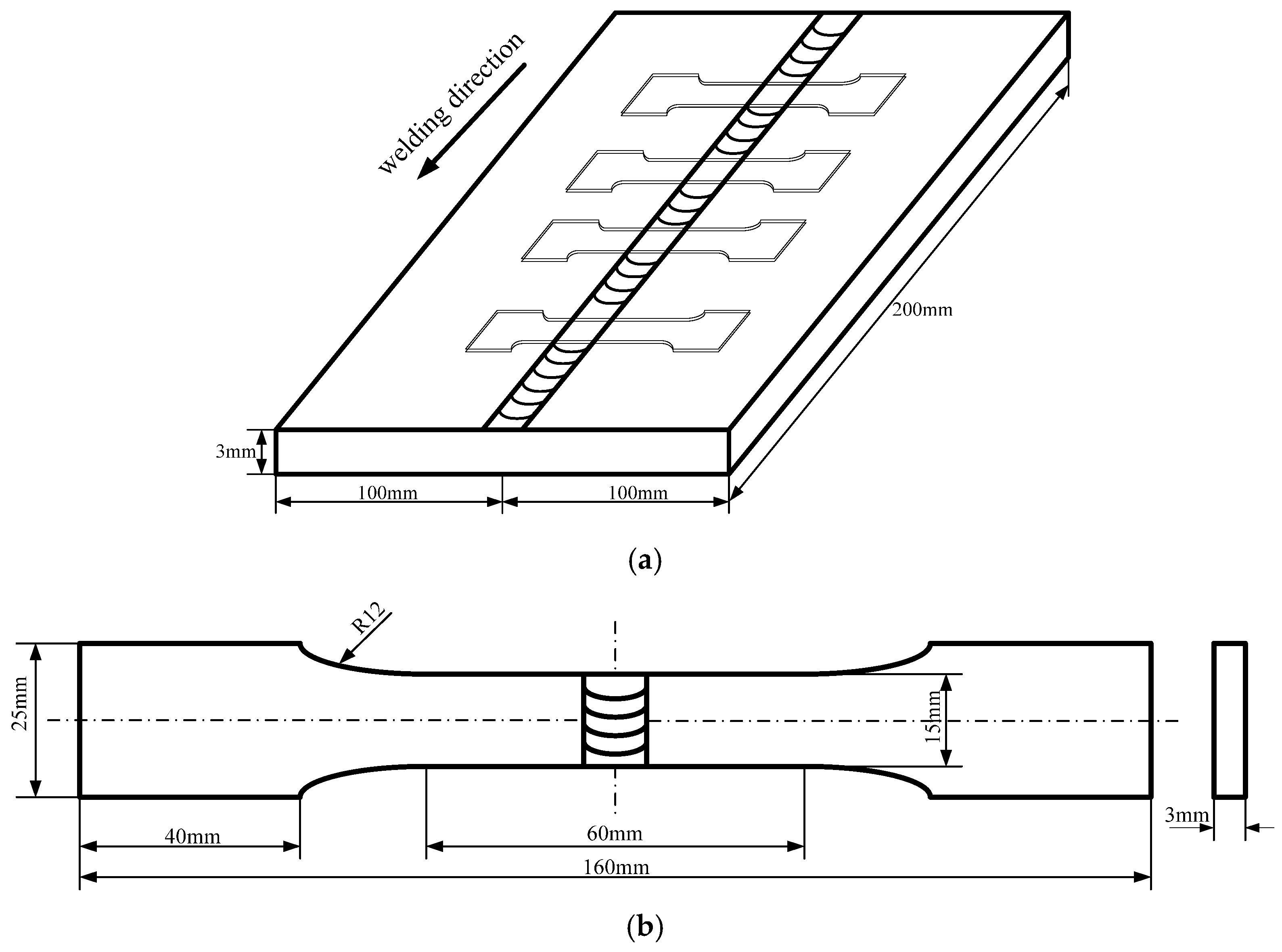
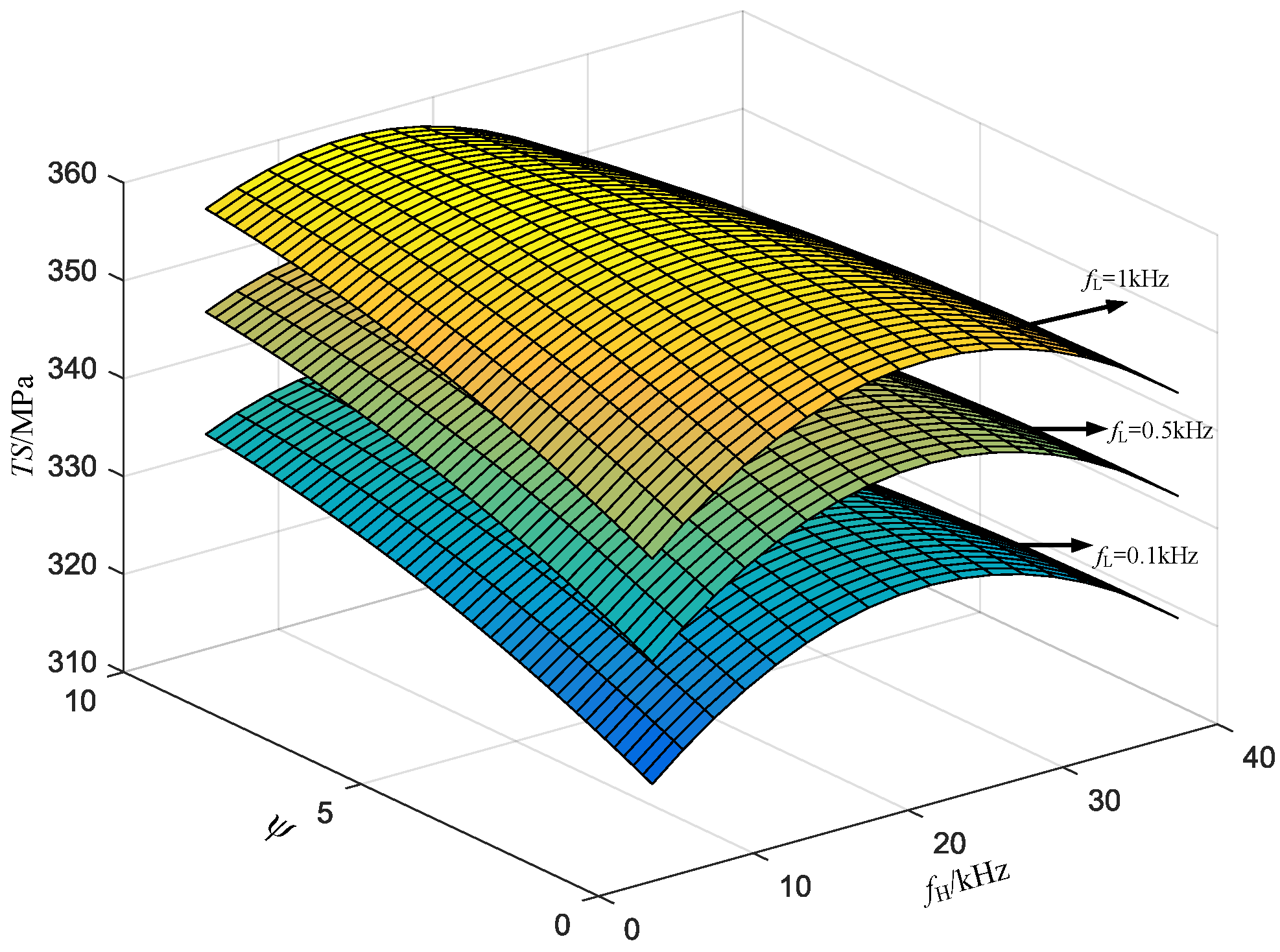
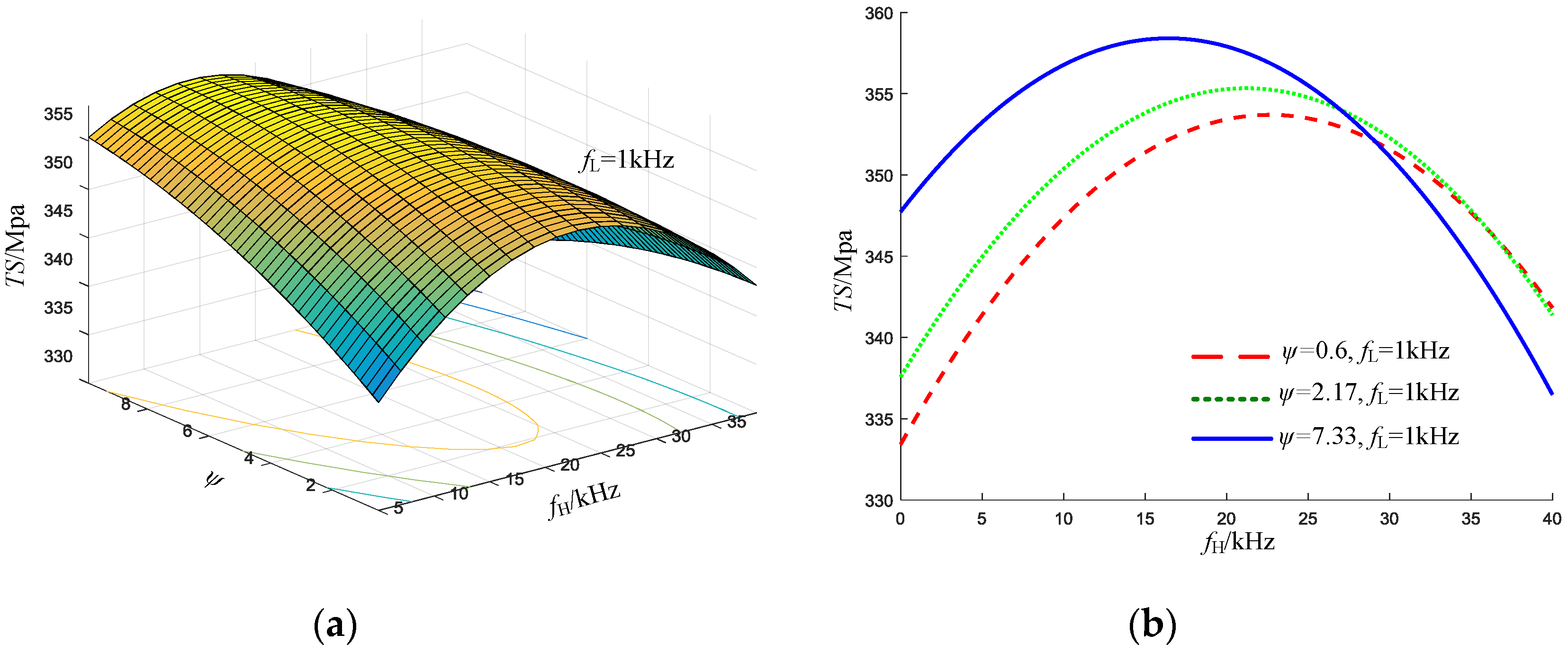

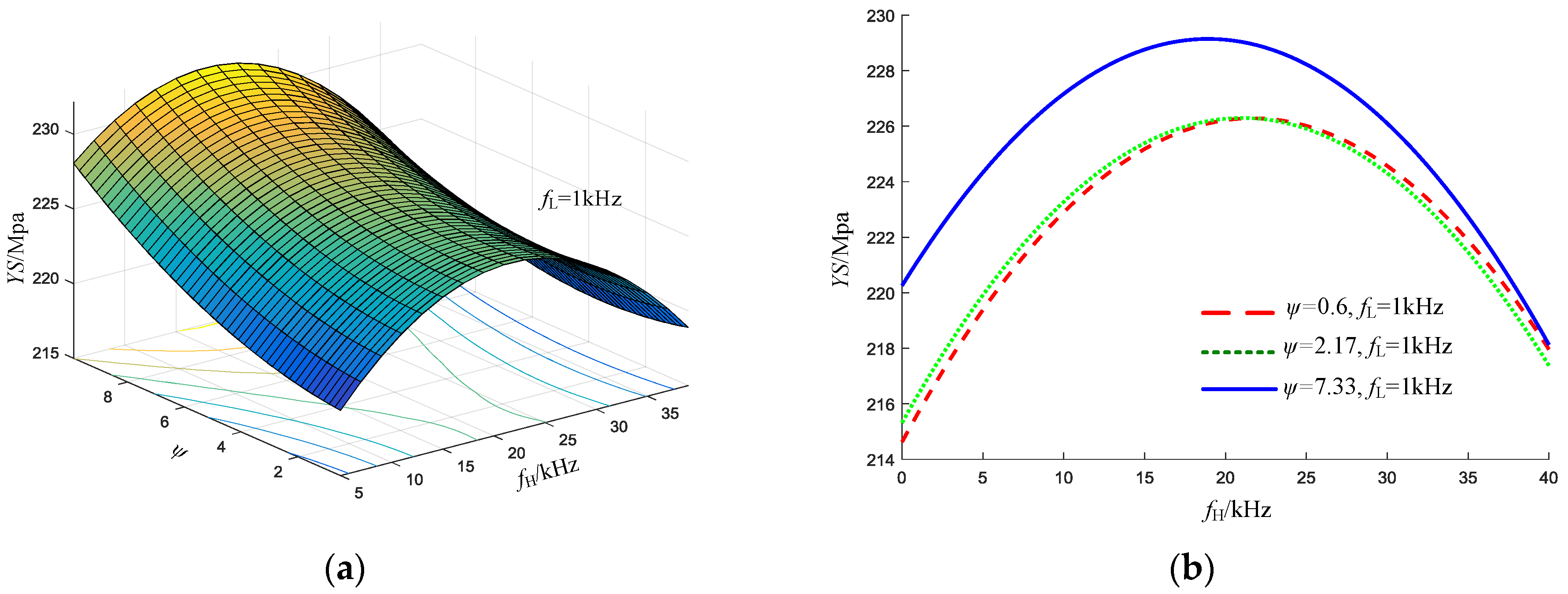



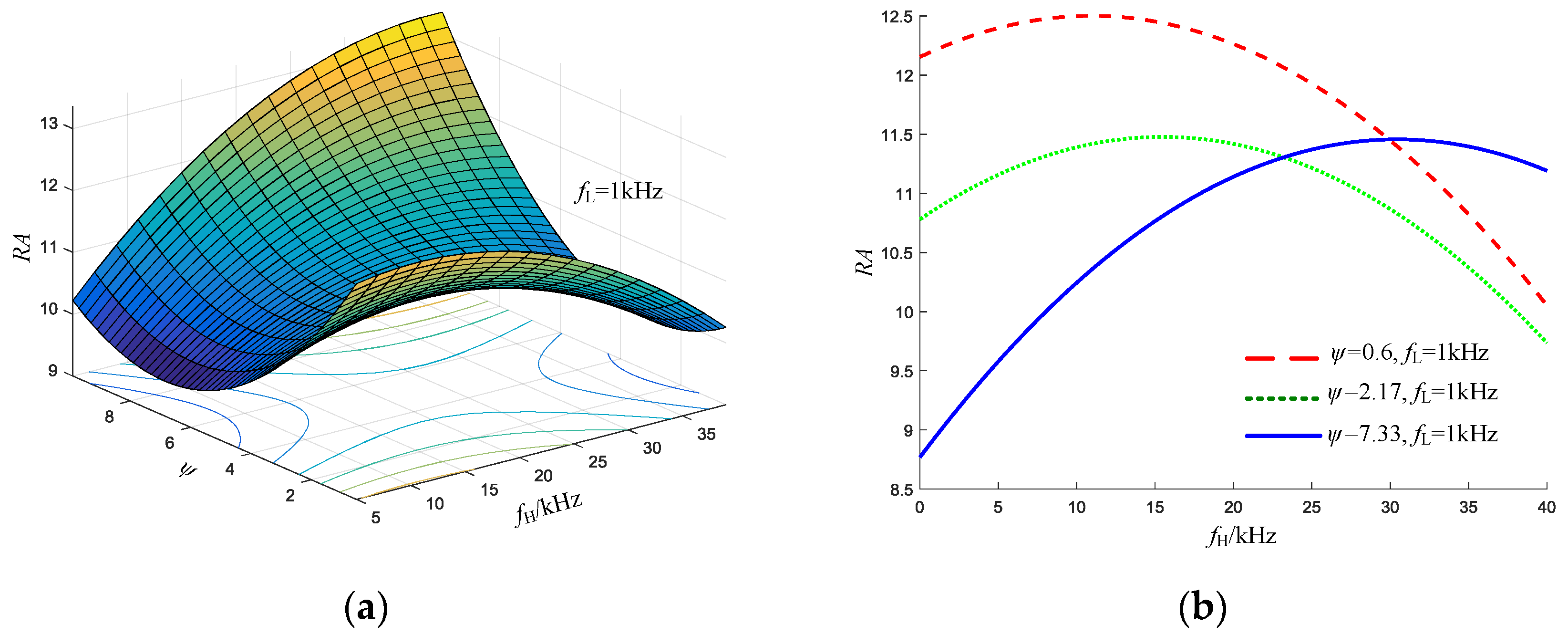
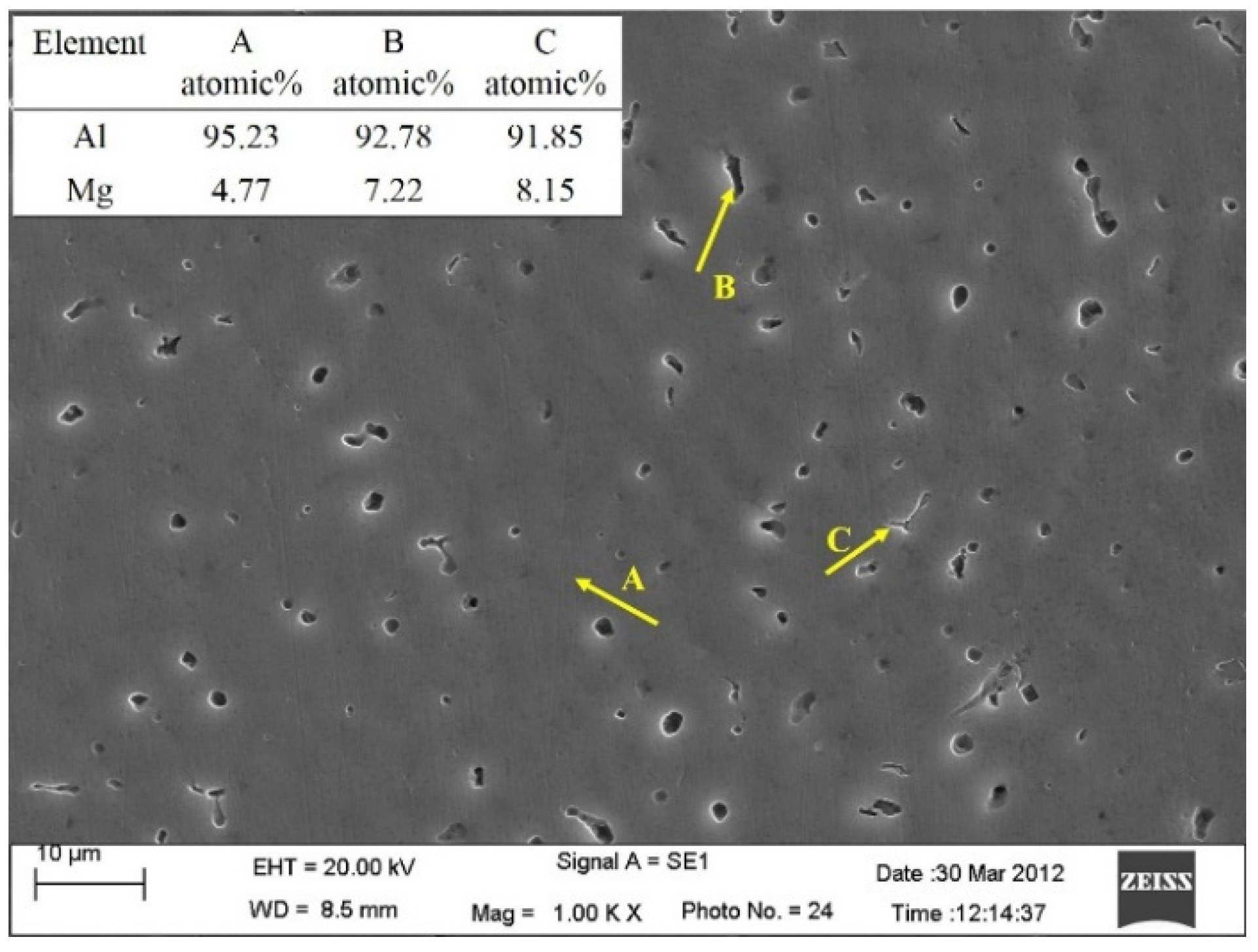
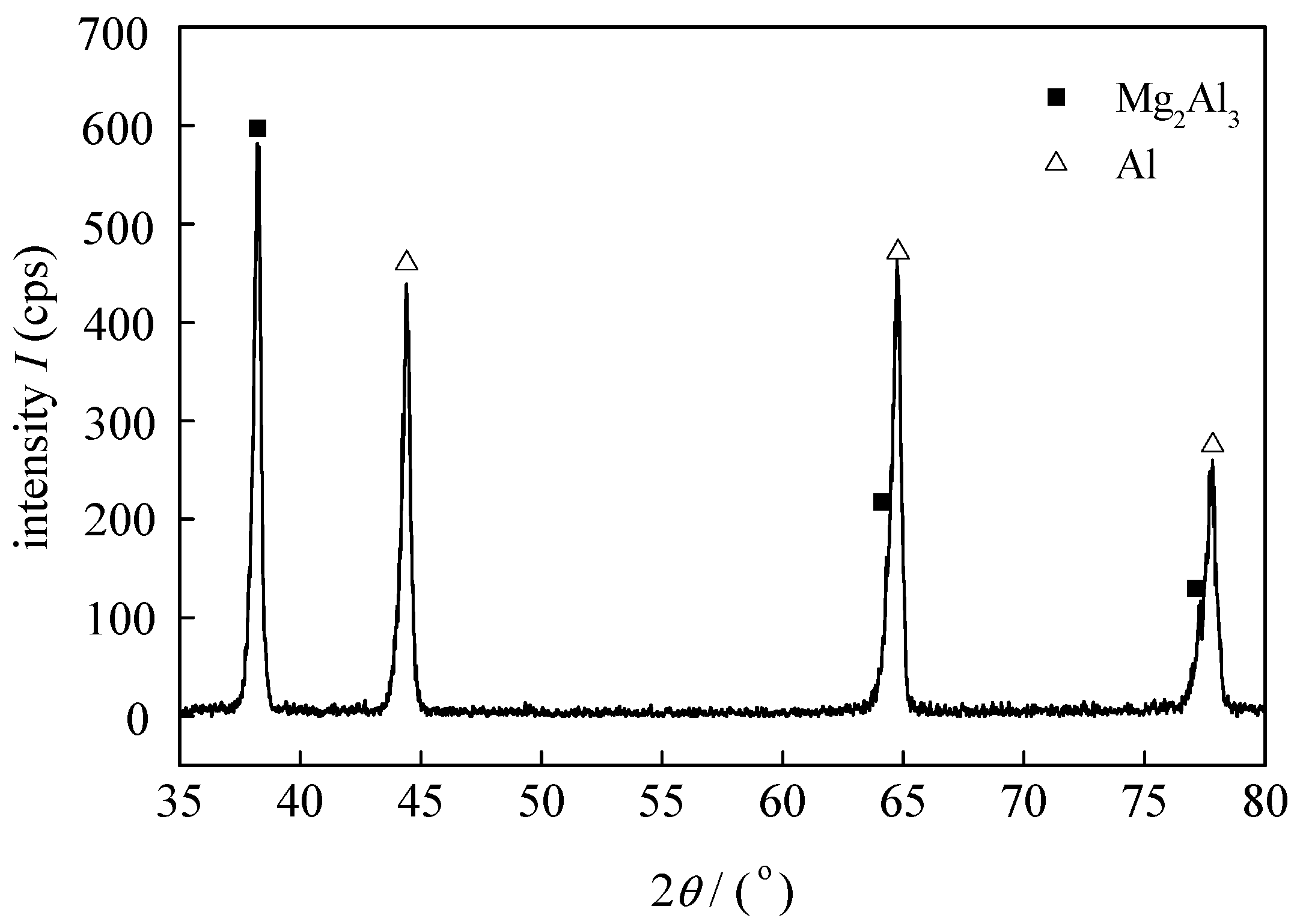
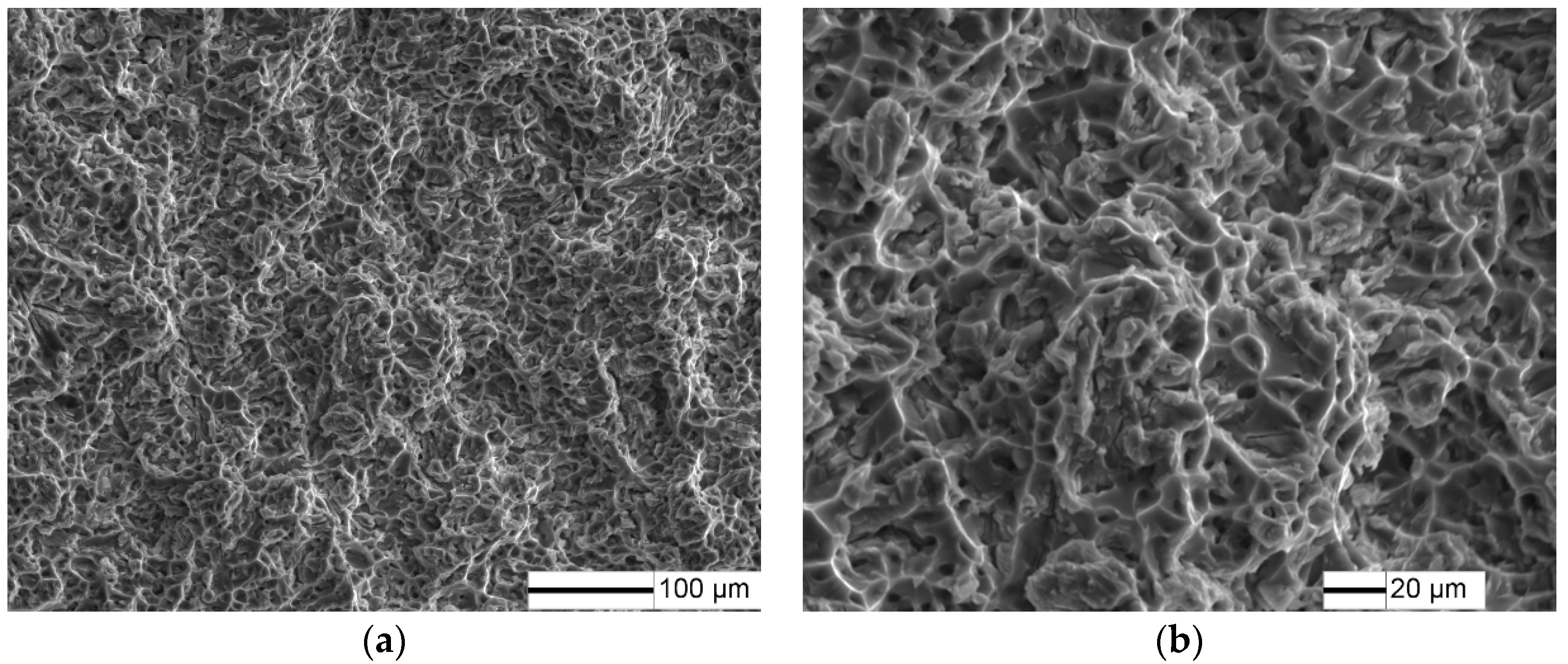
| Factor | A: fL/kHz | B: fH/kHz | C: ψ | |
|---|---|---|---|---|
| Level | ||||
| 1 | 0.1 | 5 | 0.60 (Ib = 75 A, Ip = 180 A, δ = 0.2) | |
| 2 | 0.5 | 20 | 2.17 (Ib = 60 A, Ip = 130 A, δ = 0.5) | |
| 3 | 1 | 40 | 7.33 (Ib = 60 A, Ip = 110 A, δ = 0.8) | |
| Parameter | Symbol | Value | Unit |
|---|---|---|---|
| Filter wire | - | ER5356 φ2.4 mm | - |
| Electrode | - | WC20 φ3.0 mm | - |
| Argon flow rate | vg | 15 | L·min−1 |
| Welding velocity | vw | 150 | mm·min−1 |
| Feeding velocity | vf | 150 | mm·min−1 |
| Arc length | h | 3 | mm |
| Duration ratio | tp:tn | 8:2 | - |
| Negative polarity current | In | 120 | A |
| Factor | A: fL/kHz | B: fH/kHz | C: ψ | Null | |
|---|---|---|---|---|---|
| No. | |||||
| 1 | 1 (0.1) | 1 (5) | 1 (0.6) | 1 | |
| 2 | 1 (0.1) | 2 (20) | 2 (2.17) | 2 | |
| 3 | 1 (0.1) | 3 (40) | 3 (7.33) | 3 | |
| 4 | 2 (0.5) | 1 (5) | 2 (2.17) | 3 | |
| 5 | 2 (0.5) | 2 (20) | 3 (7.33) | 1 | |
| 6 | 2 (0.5) | 3 (40) | 1 (0.6) | 2 | |
| 7 | 3 (1) | 1 (5) | 3 (7.33) | 2 | |
| 8 | 3 (1) | 2 (20) | 1 (0.6) | 3 | |
| 9 | 3 (1) | 3 (40) | 2 (2.17) | 1 | |
| Factor | A: fL/kHz | B: fH/kHz | C: ψ | TS/MPa | YS/MPa | PE/% | RA/% | |
|---|---|---|---|---|---|---|---|---|
| No. | ||||||||
| 1 | 1 (0.1) | 1 (5) | 1 (0.6) | 311 | 198 | 7.7 | 8.4 | |
| 2 | 1 (0.1) | 2 (20) | 2 (2.17) | 335 | 211 | 7.7 | 8.6 | |
| 3 | 1 (0.1) | 3 (40) | 3 (7.33) | 318 | 204 | 8.1 | 8.6 | |
| 4 | 2 (0.5) | 1 (5) | 2 (2.17) | 339 | 213 | 7.6 | 10.9 | |
| 5 | 2 (0.5) | 2 (20) | 3 (7.33) | 340 | 215 | 7.7 | 9.5 | |
| 6 | 2 (0.5) | 3 (40) | 1 (0.6) | 334 | 210 | 7.5 | 9.6 | |
| 7 | 3 (1) | 1 (5) | 3 (7.33) | 356 | 226 | 8.4 | 9.9 | |
| 8 | 3 (1) | 2 (20) | 1 (0.6) | 358 | 229 | 9.7 | 12.8 | |
| 9 | 3 (1) | 3 (40) | 2 (2.17) | 334 | 213 | 7.6 | 8.9 | |
| Num. | fL/kHz | fH/kHz | ψ | EV | PV | Percent Deviation |
|---|---|---|---|---|---|---|
| Tensile strength | ||||||
| 1 | 0.2 | 10 | 0.98 | 324 | 327.7 | 1.2 |
| 2 | 0.2 | 30 | 0.98 | 343 | 331.4 | 3.3 |
| 3 | 0.7 | 10 | 4.2 | 330 | 332 | 0.6 |
| 4 | 0.7 | 30 | 4.2 | 341 | 331 | 2.9 |
| Yield strength | ||||||
| 1 | 0.2 | 10 | 0.98 | 213 | 215.6 | 1.3 |
| 2 | 0.2 | 30 | 0.98 | 223 | 232.7 | 4.2 |
| 3 | 0.7 | 10 | 4.2 | 219 | 226.3 | 3.2 |
| 4 | 0.7 | 30 | 4.2 | 240 | 242.1 | 0.9 |
| Percent elongation | ||||||
| 1 | 0.2 | 10 | 0.98 | 7.7 | 8.0 | 3.9 |
| 2 | 0.2 | 30 | 0.98 | 7.9 | 7.7 | 2.5 |
| 3 | 0.7 | 10 | 4.2 | 7.6 | 7.4 | 2.6 |
| 4 | 0.7 | 30 | 4.2 | 8.0 | 7.6 | 5.0 |
| Ratio of reduction in area | ||||||
| 1 | 0.2 | 10 | 0.98 | 9.6 | 9.8 | 2.0 |
| 2 | 0.2 | 30 | 0.98 | 9.4 | 8.9 | 5.3 |
| 3 | 0.7 | 10 | 4.2 | 10.4 | 10.3 | 0.9 |
| 4 | 0.7 | 30 | 4.2 | 10.8 | 10.5 | 2.7 |
© 2017 by the authors. Licensee MDPI, Basel, Switzerland. This article is an open access article distributed under the terms and conditions of the Creative Commons Attribution (CC BY) license (http://creativecommons.org/licenses/by/4.0/).
Share and Cite
Wang, Y.; Qi, B.; Cong, B.; Yang, M. Optimization of Hybrid Ultrasonic Frequency Pulsed VP-GTAW Process Parameters on Tensile Properties of AA 5456 Alloy. Appl. Sci. 2017, 7, 485. https://doi.org/10.3390/app7050485
Wang Y, Qi B, Cong B, Yang M. Optimization of Hybrid Ultrasonic Frequency Pulsed VP-GTAW Process Parameters on Tensile Properties of AA 5456 Alloy. Applied Sciences. 2017; 7(5):485. https://doi.org/10.3390/app7050485
Chicago/Turabian StyleWang, Yipeng, Bojin Qi, Baoqiang Cong, and Mingxuan Yang. 2017. "Optimization of Hybrid Ultrasonic Frequency Pulsed VP-GTAW Process Parameters on Tensile Properties of AA 5456 Alloy" Applied Sciences 7, no. 5: 485. https://doi.org/10.3390/app7050485






